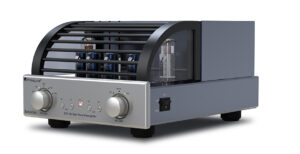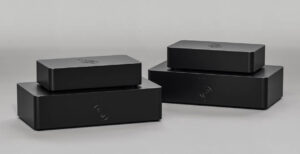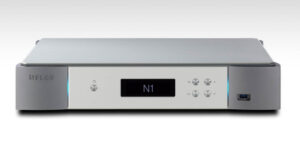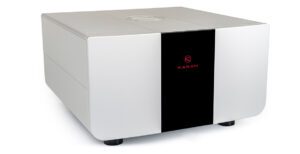
Perhaps the strangest turn in 21st Century music replay is this: how did the UK get so damn good at streaming? This isn’t simply flying the flag for Britain; UK companies were early adopters to the benefits of streaming, and while others have caught up, that commanding early lead has long kept paying out dividend in terms of high-performance streaming audio. So perhaps it should be no surprise that a brand that has been in pole position since 2007 – Linn Products – has reworked its flagship Klimax DSM streaming player to produce an identically-named replacement.
In fact, the name is one of the few things this Klimax DSM shares with its predecessor. This is an entirely different streamer for a market that has become ever more discerning and wanting to extract the best possible from networked audio. Although Linn itself might argue that the point of transition – from physical digital media to local networked and ultimately online streamed music – occurred more than a decade ago (hifiplus.com/articles/linn-products-announce-the-death-of-cd/), it took some time for the rest of the world to catch up. However, catch up it did, and the world has largely moved from considering streaming as the poor relation in digital music replay to being the primary source of music, and with that comes a desire to hear that music in its best possible context. While that has meant a whole new sub-set of the audio world has sprung up producing audiophile-chummy versions of domestic network audio devices and cables, the need for a damn good streamer remains. And in the case of the Linn Klimax DSM at least, that damn good streamer now becomes the damn good heart of a damn good system too.

I don’t want to focus on the styling, as there is a whole lot of tech going on under the hood that makes the Klimax DSM just so advanced when put against its peers, but you just can’t help be drawn to those looks. Klimax DSM is one of those products where the images look great, and yet still don’t do the product justice when compared in the flesh. It’s a bold departure from the ‘smiley-face shiny pizza box’ styling of its predecessor – and with its top dial is clearly designed more to sit on its own rather than in a rack full of shiny toys, but it does ‘understated elegance’ supremely well. It’s full of those clever touches like a screwless case, a front display that blends invisibly into the front panel, a set of configurable buttons that wouldn’t feel out of place in the passenger compartment of a Rolls-Royce, and a central top-mounted dial that is so tactile, and makes such a bold-as-brass statement about Linn’s Clydesdale home, you can’t help but be drawn to it. The nearest to criticism I’ve heard here is it looks as if it is made for someone in a Huf Haus full of Ercol furniture; in other words, it’s too elegantly designed for audio!
Then there’s the grooved top panel, designed specifically to remind users that Linn is both a music-led company and that it cut its teeth on record-players. Remarkably, it’s getting close to half a century of Linn Sondek LP12 turntable production, and the venerable, continually-amended design still shows no sign of aging; not even greying round the p-clips! Those with an LP12 in its current top-spec will view the Klimax DSM as its visual and sonic peer; those without a record player will like the grooves as a nice flourish, and those with another brand of high-end turntable might reconsider their options.
But it’s what’s inside that counts, and it’s here that Linn has distilled all of its recent work on digital audio design, and taken it to a new level. The headline ‘new level’ is the brand’s new ‘Organik’ DAC. Hitherto, Linn’s engineers were content with drilling down into the darkest recesses of a DAC, to ensure each sub-system within the DAC chip itself was carefully fed. This was called ‘Katalyst’. However, where Katalyst took someone else’s digital converter and made it as good as Linn thought it could take that chip, ‘Organik’ is a custom DAC, with the processor written in code and stored in FPGA chips (that’s ‘Field-Programmable Gate Array’ and nothing to do with swearing at pro-golfers) and a discrete conversion stage.
According to Linn itself, this “powerful FPGA processing stage uses custom-designed algorithms to provide increased upsampling, more precise volume control, and distortion free modulation. Its partnering discrete conversion stage renders the analogue signal with extremely low levels of distortion thanks to a new ultra-low jitter oscillator and carefully designed clock distribution network.”

In fairness, this is mostly ‘new to Linn’ than a completely ‘new’ concept, but once again without seeming to wave the Union flag from the rooftops, why are so many top-line British companies willing to go that extra mile and develop their own DAC, rather than choose an off-the-peg design? With Linn joining a select list of UK-based digital brands who also write their own DAC, it shows the UK to be a true digital centre of excellence.
Of course, rolling its own digits provides the company with greater control over its digital destiny, and unlocks the brand from having to dance to the tune of the chip-maker. Given we saw the AKM chip-fabbing plant burn to the ground last year, and the previous version of the Klimax DSM used the AK4497EQ digital converter chip, not dancing to the digital chip-maker’s tune sounds like a good idea.
More importantly, from a company perspective, making your own digital converter means you can shape the sound to suit your brand’s requirements. In base terms, while Linn’s boss Gilad Tiefenbrun was once extremely dismissive of DSD, the new Klimax DSM supports DSD256, alongside 24-bit, 384kHz PCM. MQA in all its guises is not on the Linn map, however. But it also allows closer integration with other digital sources and clever bits of Linn technology like Space Optimisation; this last allows the user to encode the speakers and basic parameters of the room into the decoding process, allowing the listener to dial out a significant portion of the room’s acoustic influence in the digital domain, without the need for sonic measurement or more heavy-handed DSP found in some systems. While this is the kind of set-up function that could be performed by any end user, a trained and intelligent dealer who has had experience of installing the system in a number of rooms helps a lot.
There are two and a bit versions of the Klimax DSM now. The first is the all-audio version, the second is the AV version that comes with HDMI connections. As these are identically priced, I’d say go with the AV version as it adds flexibility without undermining performance or sacrificing inputs or outputs. However, while these sections are the most physically isolated inputs possible, there remain audiophiles around the world who respond to the inclusion of AV inputs with a case of hives, so if you fall into that group, go with the audio-only option. Then there’s the Klimax Hub option, which costs £15,000 and doesn’t include any DAC option, because it’s the preamp/hub for active Klimax 350 loudspeakers. The Klimax 350 speakers now include the Organik DAC as standard, and there is an upgrade for existing owners.
Linn has famously made its products as open-source as possible (which might explain why the closed-loop of MQA remains anathema to Linn). Meaning that while you are strongly encouraged to use the Klimax DSM with the Linn App to control it, Linn Kazoo to select, search, and play your music, Linn Kazoo Server to store that music and Linn Konfig to set-up and manage your system, you could forge your own path… ish. I’d say trying to set-up a Linn Klimax DSM without using Linn Konfig is a bit like trying to sew on a button with a hammer, and I would also say that unless you have a pathological dislike of using Linn’s own software, use the damn programs. That being said, I’d like to see the Linn App speak to Android phones and tablets, and I hope Kazoo Media can one-day work with Apple M1-chip computers and more than just QNAP NAS drives. Fortunately, my older Mac Book Pro is still serviceable and was pressed into service as a server. Although ‘Roon Tested’ rather than ‘Roon Ready,’ Linn and Roon work well together.
Linn’s streamers have a characteristic sound that still holds here. It’s dry… like a good martini, not a desert. That gives the music a sense of directness and focus, but can trade speed for space, creating a tight ball of sound that sits between the loudspeakers. In the Klimax, however, you get both that precision of speed and good spatial properties, without sacrificing the ‘… like a good martini’ part. No extra padding, no euphonic ‘niceness’ or anything like that is added to the sound, because it’s not needed to be added to the sound. Who needs ‘padding’ when you’ve got ‘direct’?

That directness has always been a strong Linn streamer suit, but it takes on powerful proportions here. I played one of the more challenging classical pieces I’ve heard in years; Orange by Caroline Shaw and the Attacca Quartet [New Am/Nonesuch]. The composition is inspired by gardening, and while some parts are beautiful and refined, others are dense, woody and wild. Often, it sounds like no garden you’d want to be in, but here the whole performance sounds more contiguous and whole. Yes it has the same dynamic range and can get more than a little screechy, but you do get the sense of someone trying to make music more synesthetic and include colour, smell and the physical aspects of the outside world. It’s oddly relaxing inside an album that often gets turned off after about a minute for sounding too much like a string quartet pretending to be seagulls. That’s not to say the Linn is laidback or the sound is polite; when called on, the angular sound of this recording is harsh and powerful, but the Linn gets beyond that surface sound to make something far more musically interesting, and places you at the heart of the music in a way I’ve not heard before from the album. It’s truly inspiring.
A reviewer’s job is to trip products up, but the best products trip us up instead. When this happens, we play music that we think will show limitations in a device, and they end up highlighting their strengths instead. So it was with the Klimax DSM; I played the Overture to The Pirates of Penzance [D’Oyly Carte, Decca] which is a great test for imaging, but ended up being so musically bouncy and fun (as it should be) I felt like I should have mutton-chops and be wearing a smoking jacket. I played ‘Back In Black’ by AC/DC [Atlantic] on Tidal and air-guitared my way to dislocating a shoulder and I played some Miles Davis to check on that complex interplay on Shhh/Peaceful [In A Silent Way, Columbia] and now I have a $1,000 per day coke habit. And that’s the big thing about the Linn Klimax DSM; you feel rolling out the same old terms for audio performance when you are dealing with a product that is so very much about the music isn’t just wrong, it’s positively asinine. Of course, it ticks all the audiophile boxes of good soundstaging, outstanding levels of detail, excellent vocal articulation, superb image solidity and dynamic range and fluidity of sound that could give a turntable a run for its money, but that’s just par for the course in high-end streaming. What this gives over and above that is a sense of being as one with the musical intentions of the composer or musicians.
Another way of looking at this is it takes what the already excellent Linn Klimax DSM did and tears up that product’s rules of musical engagement in a very positive way. The older Klimax DSM got out of the way of the music better than most, but the new model makes that performance sound intrusive, arch, and overly mechanical by comparison. It’s still a world-class streamer, but the new model pushes those boundaries way further than ever.

The Linn Klimax DSM is one of those ultra-rare products that resets what you thought possible from a component, in this case streaming. If you are already down the top-tier Linn rabbit hole then this is a ‘must include’ on your wish list. But even those with absolutely nothing from the Scottish brand should put this on their ‘must hear’ list, simply because it gives you an insight into what streaming is truly capable of. Let’s not mince words; this is the best streaming audio component I’ve ever reviewed.
TECHNICAL SPECIFICATIONS
- Digital Inputs: Toslink: × 1, RCA S/PDIF: × 2 (1 configurable as an output), USB Type: B × 1, HDMI: × 4, HDMI ARC × 1 (via HDMI out), Ethernet: × 1 (1000BASE-T RJ45), Optical Ethernet: × 1 (SFP socket), Wi-Fi (802.11ac), Bluetooth (4.2)
- Analogue inputs: RCA Phono: × 2 pairs, Balanced: XLR × 1 pair
Digital Outputs: HDMI: × 1 - Analogue Outputs: RCA Phono: x 1 pair, Balanced XLR: × 1 pair
- Exakt Link: × 2
- HDMI Specification: HDMI 2.0
HDMI support: 4K res @60Hz 4:4:4; HDCP 2.2; HDR; eARC; CEC - Formats supported: FLAC, ALAC, WAV, DSD (64/128/256), MP3, WMA (except lossless), AIFF, AAC, OGG
- Integrated Services supported: Tidal, Qobuz, Spotify Connect, Airplay, Roon, TuneIn, Calm Radio
- Resolution: Up to 24-bit 384 kHz
- Screen Type: 1600 × 480 TFT display
- Dimensions (W×H×D): 35 × 13 × 35cm
- Weight: 16.4 kg
- Price: £30,000
Manufacturer: Linn Products Ltd
URL: linn.co.uk
Tel: +44(0)141 307 7777
By Alan Sircom
More articles from this authorRead Next From Review
See all
PrimaLuna EVO 100 phono preamplifier
- Apr 22, 2024

Reiki Audio SuperSwitch Master Pro + Servant Pro
- Mar 27, 2024

Melco Audio N1-S38 music server
- Mar 27, 2024











